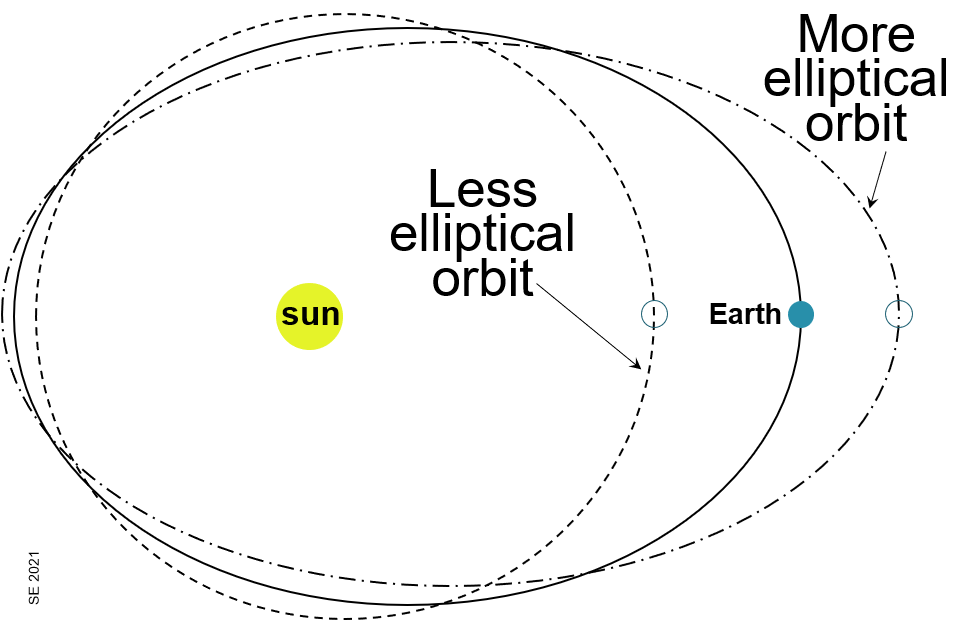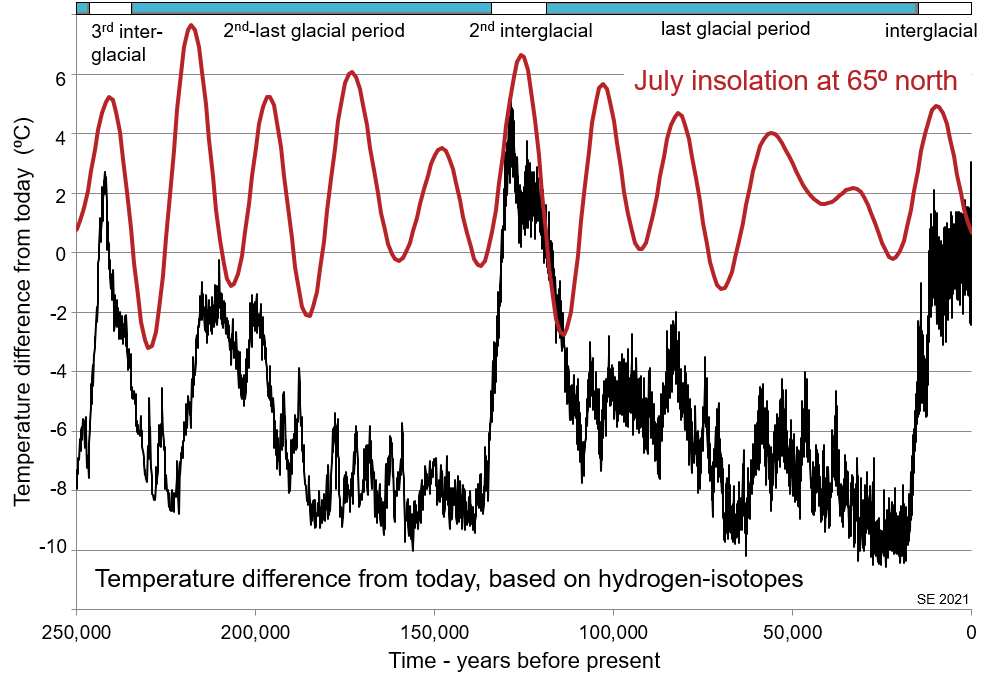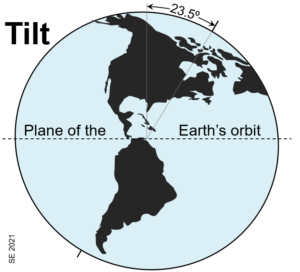3.4 Earth’s Orbital Fluctuations and Climate Change
Steve Earle
The Earth orbits around the sun in a nearly circular orbit, and it spins on an axis that is tilted at about 23.5⁰. The non-circular nature of the orbit varies over time, and both the tilt angle and the direction in which the spin axis points, also vary. It turns out that these small variations in the parameters of the Earth’s movement—known as Milanković cycles—have significant implications for our climate.
The shape of the Earth’s orbit around the sun is depicted on Figure 3.4.1. It is an elliptical shape, and the sun is not situated at the exact centre of that ellipse, but a little off to one side (this eccentricity is typical of all orbital relationships). On a consistent 100,000 year cycle, the shape changes from just a little bit elliptical, to a bit more elliptical, then back to just a little bit ellipitical. When the orbit is more elliptical the eccentricity of the sun’s position within the orbit is also more extreme, and so the difference between the minimum and maximum Earth-sun distances is higher. The degree of eccentricity has an effect on our climate, and so, on a time scale of 100,000 years that effect increases and decreases.

The second important feature of Earth’s motion is the tilt of the rotational axis (also known as obliquity) relative to the plane of the orbit around the sun (Figure 3.4.2). At present our axis is tilted at 23.5⁰ from “vertical”, but that varies from 22.1⁰ to 24.5⁰ and back to 22.1⁰ on a time scale of close to 41,000 years.
The tilt of the Earth’s rotational axis is what gives us seasons. We have summer in the northern hemisphere when the Earth is in the part of its orbit where the northern hemisphere is pointed towards the sun, and summer in the southern hemisphere summer when the southern hemisphere is pointed towards the sun. At times of greater tilt, the seasons are slightly more exaggerated than they are now (colder winters, hotter summers). At times of lesser tilt, they are less exaggerated (warmer winters, cooler summers). The tilt angle varies on a cycle of 40,000 years.
The third aspect of the Earth to consider is the variation in the direction of tilt (also known as precession). The Earth’s spin tends to keep it pointing in the same direction (just as a gyroscope tends to be stable), but in fact that direction is very slowly changing, such that in 23,000 years from now it will be pointing in the opposite direction. This cycle is important because it determines which hemisphere (north or south) will be farthest away from the sun during the summer, and that is really what drives glacial cycles.
The cyclical variations described above have implications for our climate, and especially for the advance and retreat of glaciers. From year to year, and even over thousands of years, the amount of energy the whole Earth receives from the sun doesn’t change at all, but they do produce changes in the intensity of that solar energy at any particular latitude, and in the intensity at any particular time of year. The Yugoslavian mathematician Milutin Milanković realized, for example, that glaciers grow best at temperate latitudes—in fact at around 65⁰ north or 65⁰ south[1]—and that they can only start growing on land. 65⁰ north passes through Alaska, northern Canada, Greenland, Iceland, Scandinavia and Russia. It’s pretty much land the whole way. On the other hand, 65⁰ south is entirely in the Southern Ocean. There is almost no land at all, and so there is very little chance for glaciers to start forming in that area.
Based on this information Milanković decided that insolation variations at 65⁰ north were what mattered the most to the climate, and so he calculated the variations at that latitude. He also focused on insolation intensity in summer because he was aware that cool summers are more important than cold winters to the growth of glaciers. That may be counterintuitive, but it’s because less snow melts when the summers are cool, and also because cold winters tend to be drier than warm winters and so less snow falls.
The climate and glaciation effects of the three orbital parameters: eccentricity, tilt and tilt direction, are summarized in Table 3.4.1.
| Variation | Effect |
| Eccentricity (100,000 year cycles) |
Eccentricity controls the differences in Earth-sun distances, and so in conjunction with the tilt direction, it determines how close or far the Earth is during the northern hemisphere summer. The farther the sun is from the Earth, the less effective it is in warming us.
|
| Tilt angle (41,000 year cycles) | A greater tilt angle exaggerates seasonal differences. A lesser tilt angle leads to cooler summers and warmer winters and that favours the growth of glaciers. |
|
Tilt direction
(23,000 year cycles)
|
Tilt direction is the key because it determines which hemisphere (north or south) is pointing towards the sun when the Earth is farthest away from the sun. Glaciation is favoured when the Earth-sun distance is greatest during the northern hemisphere summer, leading to cool summers with less melting. |
Milanković published his research on orbital cycles in 1941. Alas, his theory was so far ahead of its time that there wasn’t enough evidence to demonstrate that it was reasonable. The first problem was that although it was widely accepted that glaciers had come and gone several times during the past million years, the timing of those events wasn’t well known. So, while Milanković was able to use his theory to estimate the timing of past glaciations, there was no way to verify his estimates. Another problem was that the calculated differences in insolation at 65⁰ N would not have been enough to drive glacial cycles. It turns out that the sceptics didn’t recognize the importance of climate feedbacks in amplifying the weak forcing of insolation differences. For example, as it starts to cool at 65⁰ N more snow falls, and because the summers are especially cool, less of that snow melts. The reflectivity of surfaces goes up, and that leads to more cooling. As the atmosphere cools so does the ocean, and that means that CO2 becomes more soluble in the ocean water and more of it comes out of the atmosphere, leading to even more cooling.
During the middle part of the 20th century marine scientists and geologists started drilling into the soft sediments on the sea floor. The resulting cores provided a wealth of information about past marine life and conditions of sedimentation, and based on isotopic analyses, the temperature of the water. A key paper, published in 1976, clearly showed the relationship between those temperature variations and the astronomical cycles. The authors wrote: “It is concluded that changes in the earth’s orbital geometry are the fundamental cause of the succession of Quaternary ice ages.”[2] This was the turning point for the Milanković concept. Since then, thousands of studies of climate variations have corroborated the key role played by the Milanković cycles, both during the Quaternary glaciations and in other climate cycles (e.g., Monsoons) for millions of years before then.
It’s important to be clear that the Milanković cycles did not cause the Quaternary glaciations. Instead, it was the long slow decline in global temperatures of the past 50 million years, which was mostly a result of enhanced weathering of the rocks in mountain ranges (as summarized on Figure 3.2.3). That long period of cooling brought the Earth to the point where glaciation was possible; since then the Milanković cycles have been the pacemaker of the glacial cycles.
In the 1970s a consortium of glaciologists from several countries started drilling through the thick glacial ice of Greenland and Antarctica. Over the next few decades, they recovered ice cores from holes extending down thousands of metres, retrieving samples of ice that had been laid down up to hundreds of thousands of years earlier. These cores not only allowed isotopic estimates of the temperatures at the time, but provided actual samples of the atmosphere (locked in bubbles in the ice) as it existed when the ice formed. And, unlike the deep-sea sediment cores, the ice cores have well-defined annual layers, so they can be time calibrated accurately (Figure 3.4.3).[3]
The black line on Figure 3.4.3 shows the temperature of the ice that formed on Antarctica over the past 250,000 years (compared with today’s temperature). The correlation between the temperature record and the July insolation levels is reasonably clear. The 3rd-last interglacial—extending from 245,000 to 235,000 years—corresponds with a period of high insolation. The following very low insolation initiated the beginning of the 2nd-last glacial period. That was followed by a very high insolation period (at around 220,000 years)—which led to significant warming but wasn’t enough to break the glacial cycle. Glacial conditions then intensified over the next 90,000 years.

Another period of very high insolation, culminating at around 120,000 years, was able to break the cycle, leading to the 2nd interglacial, which lasted from about 127,000 to 116,000 years ago. That was followed by a similar cycle of increasingly cold climates and strong glaciation until around 20,000 years ago, when the glacial cycle was again broken by a period of strong insolation.
Media Attributions
- Figure 3.4.1 Steven Earle, CC BY 4.0
- Figure 3.4.2 Steven Earle, CC BY 4.0
- Figure 3.4.3 Steven Earle, CC BY 4.0. The data shown here are from Jouzel, J. (2004). 740,000-year Deuterium Record in an Ice Core from Dome C, Antarctica. EPICA Dome C Ice Cores Deuterium Data. IGBP PAGES, World Data Center for Paleoclimatology, Data Contribution Series # 2004 – 038. NOAA/NGDC Paleoclimatology Program, Boulder CO, USA. https://doi.org/10.3334/CDIAC/cli.007
- Latitude 65⁰—north or south—is ideal for the growth of glaciers because summers can be cool enough for some of the winter snow to last through the year, and because there is generally more snow than in areas to the north or south. ↵
- Hays, J., Imbrie, J., and Shackleton, N. (1976). Variations in the Earth's Orbit: Pacemaker of the ice ages. Science, 194(4270), 1121-1132. http://www.jstor.org/stable/1743620 ↵
- Time calibration of ice cores is done by counting layers in the ice, and also by radiometrically dating volcanic ash layers in the ice and, in some cases, correlating ash layers with eruptions for which the dates are known. ↵

